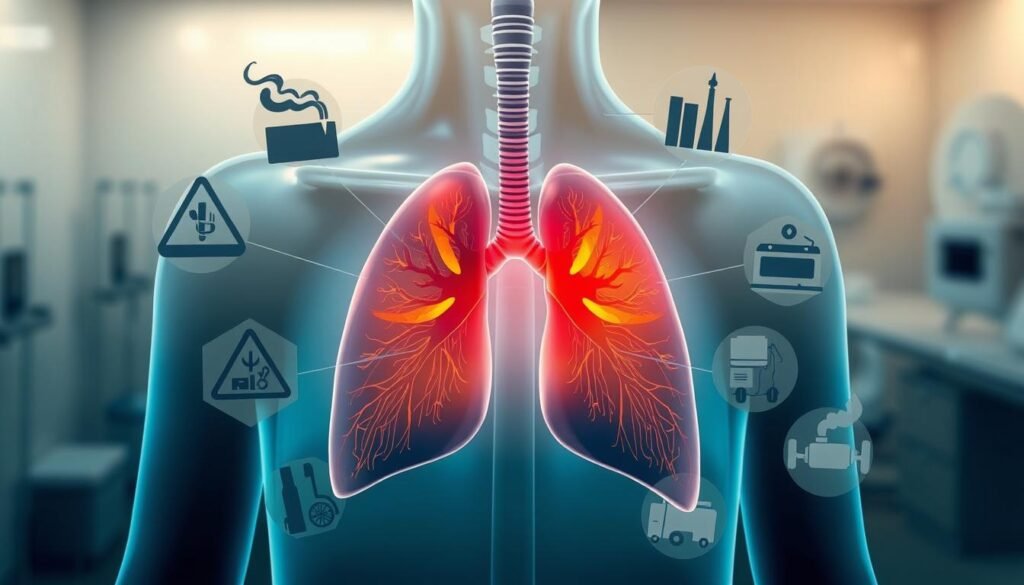About 87% of lung cancer deaths in the U.S. link back to smoking. This big number shows how important our life choices are for our health. With lung cancer as the top cancer killer for men and women, it’s vital to know how to prevent it. Especially if you’re at risk of radiation-induced lung cancer. Things like radiation exposure, smoking, your family’s health history, and environmental dangers can up your risk.
In this article, we’ll check out many ways to lower the risks that come with radiation exposure. It’s all about knowing the risks and taking steps to avoid them. By understanding the risks of smoking and living healthier, we can fight against radiation-induced lung cancer. These steps are key to keeping your lungs healthy.
Key Takeaways
- Smoking is responsible for the majority of lung cancer cases, highlighting the need for robust prevention strategies.
- Radiation exposure, along with factors like family history, increases lung cancer risk.
- Quitting smoking can significantly reduce the risk of lung cancer over time.
- Environmental factors, including radon and secondhand smoke, are important to monitor.
- A healthy diet and regular exercise may contribute to lung cancer prevention efforts.
Understanding Radiation-Induced Lung Cancer
Radiation-induced lung cancer is a serious health issue. It affects people exposed to ionizing radiation, from medical treatments or environmental factors. This can cause cancerous cells to grow in the lungs. The root cause is DNA damage from ionizing radiation. This damage disturbs cell function and starts cancer.
Different things lead to radiation exposure. X-rays and CT scans, essential for diagnosing health conditions, are common sources. Yet, they come with risks, especially if done often or at high doses. Radiation therapy for non-small cell lung cancer causes pneumonitis in 9.4% of cases. This shows the risk of lung issues during treatment.
The risk of getting radiation-induced lung cancer goes up with age. A study showed that patients older than 70 have more chance of severe lung injury. This makes understanding lung cancer complex. It shows the need for treatment plans that consider age. It aims to manage cancer and reduce lung damage.
Thanks to new technology, reducing lung damage from radiation is possible. Intensity-modulated radiation therapy (IMRT) and proton beam therapy are helping. They limit damage to healthy lung tissue. This is key in making treatment safer. It’s vital to keep evaluating these methods to improve patient safety and results.
- Key insights into radiation-induced lung injuries encompass the following:
- Two distinct types of radiation-induced lung injury are identified: radiation pneumonitis and radiation fibrosis.
- Clinical diagnosis often faces challenges due to complications from other health conditions.
- High doses and certain fractionation regimens lead to increased lung toxicity, necessitating ongoing research.
Risk Factors for Radiation-Induced Lung Cancer
It’s vital to understand the risk factors for radiation-induced lung cancer. Events like the atomic bombings show how serious radiation exposure can lead to cancer. The link between radiation and lung cancer highlights the need to recognize personal risks, notably cancer predisposition.
Behavior plays a key role in increasing lung cancer risk. About 20% of lung cancer in smokers is due to radiation. Also, people with chronic obstructive pulmonary disease (COPD) have a higher chance of developing lung issues from radiation therapy.
Approximately 35.71% of non-small cell lung cancer patients may experience radiation-induced lung injury (RILI). Modern treatments like IMRT and SBRT introduce new risks, causing damage to healthy lung tissue.
Health issues like diabetes can make lung cancer treatments riskier, especially with high-dose radiotherapy (≥ 60 Gy). Understanding these risks helps doctors create safer treatment plans. For more information, check this PMC article.
Don’t ignore the increased lung cancer risk in HIV-positive patients. Their weaker immune systems struggle more with the effects of radiation. This situation shows the complexity of lung cancer risk factors, urging the need for more research and patient education.
Knowing the various risk factors for radiation-induced lung cancer is crucial. It helps in choosing the right treatments. For insights, look at this histology guide. It shows how tailored medicine can reduce risks.
Environmental Risk Factors and Radiation Exposure
Learning about environmental risks and radiation is key in battling lung cancer. Radon gas, a natural hazard, is a radioactive substance from the ground. It’s a major risk for lung cancer, ranking second in the U.S.
Being exposed to radon inside increases lung cancer risk, especially without good air flow.
At work, dangers like asbestos are a serious concern. People in some jobs face more lung cancer risks. Asbestos exposure makes them much more likely to get lung cancer. Smoking and asbestos together make the risk even worse.
Radiation from different sources can harm lung health too. For example, folks who’ve had radiation therapy and smoke are at bigger risk. Outdoor air pollution also plays a role in about 1% to 2% of lung cancer deaths in the U.S. These pollutants are environmental carcinogens.
Genetics add another aspect to these risks. If you have a lot of lung cancer in your family, your risk may be higher. This shows that some people might inherit a weakness to environmental dangers.
| Environmental Risk Factors | Associated Cancer Risks |
|---|---|
| Radon Gas Exposure | Second-leading cause of lung cancer in the US |
| Asbestos Workplace Exposure | Significantly increases lung cancer mortality |
| Radiation Therapy | Higher lung cancer risk compared to non-treated individuals |
| Outdoor Air Pollution | 1% to 2% of lung cancer deaths |
| Genetic Predispositions | Increased risk among relatives of lung cancer patients |
It’s vital to know and understand these risks and their link to radiation. This knowledge is crucial for prevention in the fight against lung cancer.
Preventative Steps for Those at Risk of Radiation-Induced Lung Cancer
People facing radiation should take steps to avoid lung cancer. One key action is to not smoke. This is because smoking increases radiation’s harmful effects. Learning how smoking and lung cancer are connected can motivate us to make healthier choices.
Importance of Not Smoking
Not smoking is crucial for those at risk from radiation. The numbers tell a grave story: smoking leads to 87% of lung cancer deaths in men and 70% in women. Smokers exposed to radiation are up to five times more prone to lung cancer. Every year, secondhand smoke kills over 7,000 nonsmokers from lung cancer. Stopping smoking is thus incredibly important.
Quitting Smoking and Reducing Tobacco Use
Quitting smoking brings big benefits in lowering lung cancer risk. Methods include behavioral therapies, nicotine products, and support groups. The National Cancer Institute offers help for those who want to stop smoking. Using these resources improves health and cuts lung cancer risk.
Adopting these no-smoking strategies helps everyone live healthier. It makes us think about our choices. By acting together, we can protect our lungs from cancer.

Radiation Therapy Safety Measures
Radiation therapy is key for treating cancer safely. About half of all cancer patients use radiotherapy. By 2030, nearly 12 million people a year will get radiotherapy. It’s vital to know how to limit exposure to protect patients. The goal is to attack cancer cells while keeping healthy tissues safe.
Limiting Radiation Exposure During Treatment
Safety in radiation therapy uses precise methods to lower radiation risks. Techniques like intensity-modulated radiation therapy (IMRT) let doctors adjust radiation doses. This customization enhances cancer treatment safety. It limits side effects during and after treatment by protecting normal tissues.
Use of Advanced Radiation Oncology Protocols
Modern oncology protocols, like volumetric modulated arc therapy (VMAT), improve radiation safety. They focus the therapy on tumors, sparing healthy organs nearby. As techniques get better, doctors can handle long-term side effects better. Conditions like fibrosis can show up months or years after treatment.
| Technique | Benefits | Common Side Effects |
|---|---|---|
| 3D Conformal Radiotherapy | Basic targeting of tumors | Fatigue, skin irritation |
| IMRT | Precise dose distribution | Dry mouth, nausea |
| VMAT | Rapid delivery of treatment | Hair loss, diarrhea |
The future of radiation therapy looks at making cancer treatment even safer. Keeping patients well is the main goal. These steps not only fight cancer effectively but also help improve how patients feel while getting treatment.
Lung Cancer Risk Factors to Consider
Lung cancer is a big health issue, with many factors affecting its development. Understanding lung cancer risk evaluation is key for personal health. It means looking at health history, family background, and exposure to harmful stuff.
About 85% of lung cancer cases are due to smoking. This fact shows how crucial smoking is in determining risk. People with family members who had lung cancer are more likely to get it too. Being around harmful materials at work, like asbestos and certain chemicals, also increases the risk. This is especially true for smokers. Plus, things like radon and air pollution outside add to the risk as well.
Talking with healthcare experts about health history helps with early detection. It’s important to discuss personal risk factors and how you live. For instance, smokers who had radiation for other cancers face higher lung cancer risk. This shows why we need special screening for those who are more at risk.

Knowing how lifestyle choices affect lung cancer risk is important. Using coal indoors and taking beta carotene supplements if you smoke are risky. People can lower their risk by talking openly with doctors about their health. This leads to early help and support.
Knowing these risk factors is crucial for everyone wanting to keep their lungs healthy. Being aware and making smart health choices lets people manage their risk better.
For more info on lung cancer risk factors, see CDC’s guidance on risk factors.
Strategies for Lung Cancer Screening and Early Detection
Lung cancer screening is essential for catching the disease early, especially for those at high risk. Methods like low-dose computed tomography (LDCT) are important for individuals with a history of heavy smoking. Knowing the symptoms of lung cancer helps in spotting the disease early. This leads to faster treatment.
Benefits of Low-Dose CT Scans
Low-dose CT scans are a key way to screen for lung cancer. The US Preventive Services Task Force recommends them for people aged 50 to 80 who have smoked a lot. These scans are useful because they:
- Find lung cancer early, improving the chances of successful treatment.
- Lower the death rate among heavy smokers, better than regular chest x-rays do.
- Help in accurately evaluating and managing the risks for those likely to get lung cancer.
However, it’s important to remember that low-dose CT scans have downsides. These include getting false-positive results and possibly leading to unneeded further tests. Doctors need to use these scans wisely, weighing the good against the possible bad.
Understanding Lung Cancer Symptoms
Knowing what symptoms lung cancer causes is key for getting help quickly. Symptoms to watch out for include:
- A cough that doesn’t go away and gets worse.
- Chest pain, especially when you breathe deeply.
- Unexpected weight loss or change in appetite.
- Feeling very tired all the time.
- Coughing up blood or something that looks like rust.
Being alert to these symptoms can lead someone to seek medical advice sooner. This can make a big difference in treatment success. Doctors stress the importance of talking with patients about the benefits of screening and paying attention to symptoms.
| Aspect | Low-Dose CT Scans | Chest X-Rays |
|---|---|---|
| Effectiveness in Early Detection | High sensitivity for stage I cancer | Lower effectiveness |
| Recommended Screening Frequency | Annual for high-risk individuals | Not recommended for screening |
| Associated Risks | False positives, radiation exposure | Lower doses, but still some risks |
| Insurance Coverage | Typically covered if criteria met | May not cover non-diagnostic use |
Managing Other Risk Factors
Improving lung health involves addressing various risk factors. Alongside primary lung cancer causes, it’s crucial not to ignore the effects of secondhand smoke and radon exposure. By managing secondhand smoke effectively and reducing radon levels, people can enhance their lung health and lower their cancer risk.
Reducing Secondhand Smoke Exposure
Secondhand smoke is a significant lung cancer risk. Effective management strategies can save many lives. Here are a few ways to reduce exposure:
- Establish smoke-free environments, including at home and in cars.
- Encourage family and friends to quit smoking for their and others’ health.
- Educate the community about secondhand smoke’s dangers.
- Support public policies that restrict smoking in public places.
Addressing Radon Levels in Homes
Radon is a natural, radioactive gas that can build up in houses. This increases lung cancer risk. Lowering high radon levels is critical. Here’s how to manage radon effectively:
- Use reliable radon test kits from online or local stores to check your home.
- If high levels are found, hire radon mitigation experts to reduce indoor air radon.
- Ensure homes are well-ventilated and seal radon entry points like foundation cracks.
- Retest homes for radon every few years to keep levels safe.

Adopting these strategies helps create safer environments, minimizing lung cancer risks from secondhand smoke and radon. Keeping aware and taking action are vital for healthier lungs.
Incorporating Healthy Lifestyle Changes
Choosing a healthy way of life is key to preventing cancer. Adding diet and exercise to your daily routine boosts health. It also helps prevent lung cancer. Exercise and keeping a healthy weight are vital for lung health and reducing cancer risk.
Regular Exercise and Weight Management
Regular workouts help manage weight and lower cancer risk. The American Cancer Society suggests 150 minutes of moderate or 75 minutes of intense exercise weekly. Activities like walking, swimming, or biking keep weight in check and boost immunity. People who are active have a lower chance of getting lung cancer.
The Role of a Nutrient-Rich Diet
Eating well is just as important for a healthy life. A diet full of fruits, veggies, whole grains, and lean meats fights cancer. Lots of colorful fruits and veggies provide vitamins and minerals. They have antioxidants and phytochemicals to fight cancer causes.
- Increased intake of leafy greens and cruciferous vegetables
- Incorporation of berries for their antioxidant properties
- Regular consumption of nuts and seeds for healthy fats
- Choosing whole grains over refined options for better nutrition
Changing your diet not only helps your lungs but also helps prevent all cancers. Living a life focused on diet and exercise is a strong move against cancer.
Conclusion
Understanding and addressing radiation-induced lung cancer is key to improving patient health. The main points stress the importance of knowing the risks, especially for those getting radiation therapy. This includes treatments for lung cancer, mediastinal lymphoma, or breast cancer. The stats show a clear picture; with radiation-induced lung injury (RILI) rates between 5% to 25%, focusing on health strategies is essential.
To lower the risks from radiation therapy, taking steps like reducing radiation doses, adopting newer treatment methods, and getting regular health checks is crucial. Also, living a healthy life, eating right, and staying active can help decrease lung cancer risks. By focusing on these areas, we can better protect those at risk for lung cancer.
For more on RILI’s molecular details and treatment options, check this comprehensive review here. In the end, taking the initiative for health and regular screenings can greatly improve lung health. This proactive approach is a big step in preventing radiation-induced lung cancer.